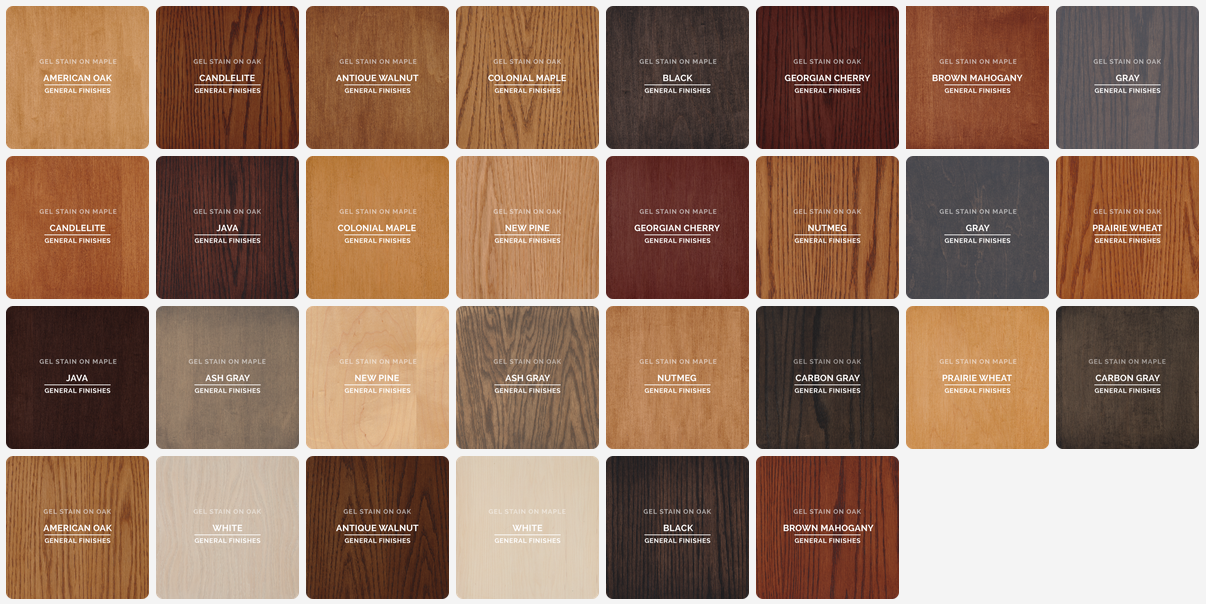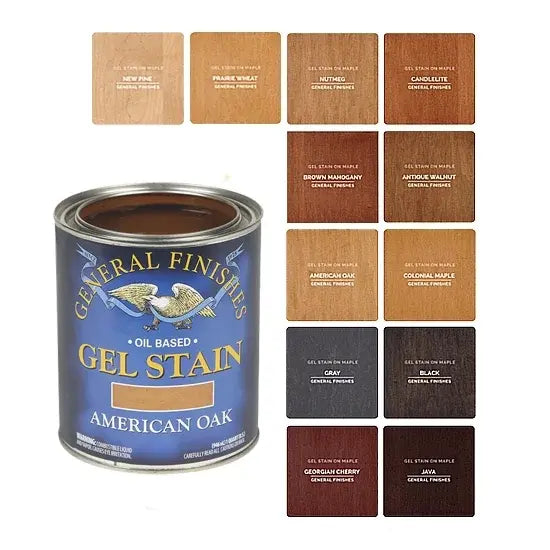General Finishes Gel Stain Application Steps
- Work in a well-ventilated area.
- Stir the stain thoroughly to reincorporate solids that have settled to the bottom of the can.
- If desired, thin stain with mineral spirits. Start by adding 5% by volume and increase up to 15% as needed.
- There is usually no need for General Finishes Pre-Stain Conditioner Natural to improve color uniformity. Gel Stain is loaded with pigments that provide deep uniform coverage.
- TEST your complete finishing process before starting. The stain color is affected by many variances including but not limited to the wood species, type of application method, and existing finishes on the substrate. The color is further deepened with the application of topcoat.
- Do NOT paint on Black Gel or Carbon Gray Stain. The pigments needed to create the black color hamper drying when Gel Stain is used as a paint rather than applying in thin layers and wiping off the excess.
- Painting on Gel Stain is NOT a recommended technique as the surface will get very dark and dry times will be longer, 72 hours, or much longer depending on the substrate and humidity. Use either paint or a dark water-based wood stain instead if you want a solid dark color. If you still want to use Gel Stain over an existing surface, we recommend this technique instead: How To Update Kitchen Cabinets Using a Dry Brush Technique. When finishes are applied over an existing finish, dry times must be increased.
- Surface Preparation is essential. See "Step 1: Preparation for Gel Stain."
- Divide your project into manageable sections: top, side, drawer, door, table seam, etc.
1. Hand-Application over Raw Wood:
See our video on How To Apply Gel Stain to a Raw Wood Surface.
- Optional: Apply a slip coat of mineral spirits over the raw wood immediately before application to facilitate the flow of stain on the surface and reduce lap marks. (This is not a conditioner.)
- Working quickly, apply a LIBERAL coat with smooth, even strokes using a natural bristle brush, foam brush, pad applicator, staining pad or microfiber roller.
Gel Stain dries quickly for all the reasons customers love it: it is loaded with colorants and solids. If not enough stain is used, the surface may dry too quickly, causing an uneven appearance.
On large surfaces, leave a wet edge between passes to prevent lap marks. We recommend getting a buddy to help apply the stain. - Stain one section at a time, leaving a wet edge between sections.
-
Wipe off the excess evenly with the grain using high-quality absorbent paper towels, shop towels or open-weave cloths, such as cotton terry towels for larger projects.
Check for missed spots and lap marks before moving to the next section.
Do NOT use cotton t-shirts to wipe away stain because they will "push" the stain around and not absorb it. - Immediately correct lap marks by rewetting the entire working area with stain and wiping off the excess.
- Pull excess stain out of corners and details with a natural bristle brush.
- Let the stain dry 12-24 hours in ideal conditions: 70°F/20°C, 50% humidity. Inadequate dry time is one of the top reasons for Gel Stain finish failure. If in doubt, wait longer. Increase dry time if:
- Humidity is over 80%
- 3+ coats are applied (not recommended)
- Thick coats are applied
- Layering General Finishes water- and oil-based products:
- Water over oil: Let oil-based products dry 72+hr before applying water-based products
- Oil over water: Let water-based products dry 24+hr before applying oil-based products
- If applying stain over an existing finish, confirm that the finish has dried before applying another coat of stain or topcoat. Depending on the existing finish, Gel Stain can take days to dry. Be patient, and test by rubbing with a white cotton ball or white cloth. If the surface is still tacky or you can remove more than a faint trace of stain, the surface is not ready.
- If Gel Stain is tacky after 5 days, dry time requirements have not been met and it may never dry. The only alternative is to strip off the finish and start over. Reminder, always test the entire finish schedule in advance before proceeding with the entire project.
- Optional: apply a second coat to deepen the color. Apply no more than 2 coats.
- Finish with 3 coats of General Finishes topcoat, letting each coat dry 72 hours.
2. Dry Brushing Over an Existing Finish
- Finishes dry in two directions: through the air and through absorption in raw wood. When finishes are applied over an existing finish, dry times must be increased.
- See our video tutorials:
- How To Update Kitchen Cabinets Using a Dry Brush Technique
- How to Update Existing Wood Finishes With Gel Stain
- Prep cleaning and sanding is essential. See "Step 1: Preparation for Gel Stain."
- Test your complete finishing process before starting. The stain color is affected by variances in wood and deepened with the application of topcoat.
- Apply stain with a natural bristle brush or foam brush. Feather out uneven areas and pull excess stain from corners using a bristle brush. Discharge accumulated stain from the brush onto a paper towel soaked with mineral spirits as you work.
-
Let the stain dry 72+ hours in ideal conditions: 70°F/20°C, 50% humidity. You can tell if an oil-based finish is dry if it is no longer tacky, and cool to the touch. If in doubt, wait longer. Increase dry time if:
- Humidity is over 80%
- 3+ coats are applied
- Thick coats are applied
- Applying over products from other brands
- Layering General Finishes water- and oil-based products:
- Water over oil: Let oil-based products dry 72+hr before applying water-based products
- Oil over water: Let water-based products dry 24+hr before applying oil-based products
- If Gel Stain is tacky after 5 days, dry time requirements have not been met and it may never dry. The only alternative is to strip the finish off and start over.
- Optional: apply a second coat to deepen the color. Apply no more than 2 coats.
- Finish with 3 coats of General Finishes topcoat. See "Step 3: Topcoat Over Oil-Based Stain."
3. Painting on Stain Without Wiping Away (raw wood or existing finish):
- Painting on Gel Stain is NOT a recommended technique as the surface will get very dark and dry times will be longer, 72 hours, or much longer depending on the substrate and humidity. Use either paint or a dark water-based wood stain instead if you want a solid dark color. If you still want to use Gel Stain over an existing surface, we recommend this technique instead: How To Update Kitchen Cabinets Using a Dry Brush Technique. When finishes are applied over an existing finish, dry times must be increased.
- Do NOT paint on Black Gel or Carbon Gray Stain. The pigments needed to create the black color hamper drying when Gel Stain is used as a paint rather than applying in thin layers and wiping off the excess.
- When painting on Gel Stain without wiping away, let the stain dry 72+ hours or longer between coats in ideal conditions: 70°F/20°C; 50% humidity. Do not proceed with additional coats unless the stain is dry.
- Layering General Finishes water- and oil-based products:
- Water over oil: Let oil-based products dry 72+hr before applying water-based products
- Oil over water: Let water-based products dry 24+hr before applying oil-based products
- Tip: If you are using General Finishes Java Gel Stain, General Finishes recommends using General Finishes Dark Chocolate Milk Paint instead of painting on Gel Stain. This Milk Paint color matches a solid application of Java Gel Stain, is much faster to apply, and offers easy water clean-up.
Step 3: Topcoat Over Oil Based Stain
Always seal General Finishes oil-based stains with 3 coats topcoat to lock in the color. You can use either oil-based or water-based topcoat. When layering water-based and oil-based products, increase the dry time:
- Water over oil: Let oil-based products dry 72+hrs
- Oil over water: Let water-based products dry 24+hrs
Do not proceed with topcoat until Gel Stain is completely dry. Inadequate dry time is one of the top reasons for Gel Stain finish failure. You can tell if an oil-based finish is dry if it is no longer tacky, and cool to the touch. If in doubt, wait longer.
DO NOT use original formula of General Finishes Enduro-Var Topcoat with oil-based products. Enduro-Var II is compatible with all GF products.
General Finishes Arm-R-Seal
- Thinner consistency.
- Oil-based.
- Ambers.
- Available in Satin, Semi-Gloss and Gloss sheens.
- Because of its thinner consistency, Arm-R-Seal is easier to apply over large and detailed surfaces, such as kitchen cabinets.
- General Finishes most durable retail topcoat and suitable for high-use areas.
General Finishes Gel Topcoat
- Thick consistency.
- Oil-based.
- Ambers.
- Available in Satin sheen. This satin is shinier than Arm-R-Seal satin.
- Durable and suitable for high-use areas.
General Finishes High Performance or General Finishes Flat Out Flat Water Based Topcoat
- Looks "white" in the can.
- Drys clear.
- Water cleanup.
- Brush or spray.
- High Performance is very durable and suitable for high-use areas.
- Flat Out Flat is designed to look and feel like a wax finish; it is recommended for low-use projects.
Creative Finishing Techniques Using Gel Stain
Mixing Gel Colors
- Gel stains can be intermixed to create custom colors.
- Gel Stain can be mixed with no more than 10% Liquid Oil Stain is added by volume. The liquid stain will thin the stain, which may help it spread more easily but it will not have as much coverage.
- Gel Stain can be layered over other General Finishes water and oil-based stains. Allow for adequate dry time when layering water and oil products. See video tutorial: Can Oil and Water Based Finishes Be Applied on the Same Project
Cleanup of Oil Based Products
Cleanup
Clean up application materials and hands with mineral spirits or waterless hand cleaner, like Goop or Gojo.
Disposal
Take great care when disposing of product-soaked applicators. Application materials, such as brushes and towels, containing oil-based products may spontaneously catch fire if improperly discarded. Immediately place all application materials soaked with this product in a sealed, water-filled metal container. Dispose of in accordance with local fire regulations.
Spills
Clean up spills with mineral spirits immediately while wet. If oil-based finishes dry, they are difficult to clean off any surface, clothes or carpet. Carpet may discolor if cleaned with mineral spirits.
Prevention
Protect your workspace with a tarp, your hands with gloves, and your clothes with an apron.



 SDS: ENGLISH Gel Stain AMERICAN OAK Oil-Base 2023-10
SDS: ENGLISH Gel Stain AMERICAN OAK Oil-Base 2023-10 